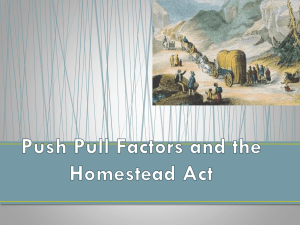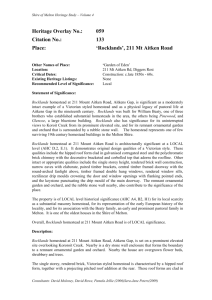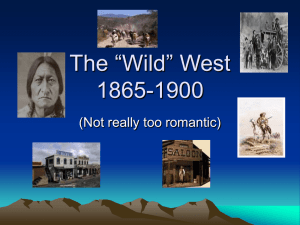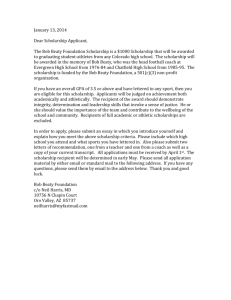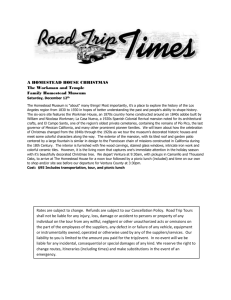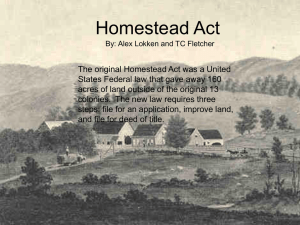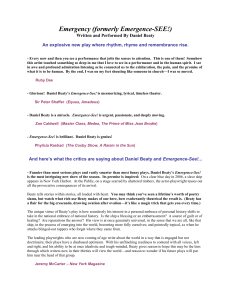Pinewood
advertisement
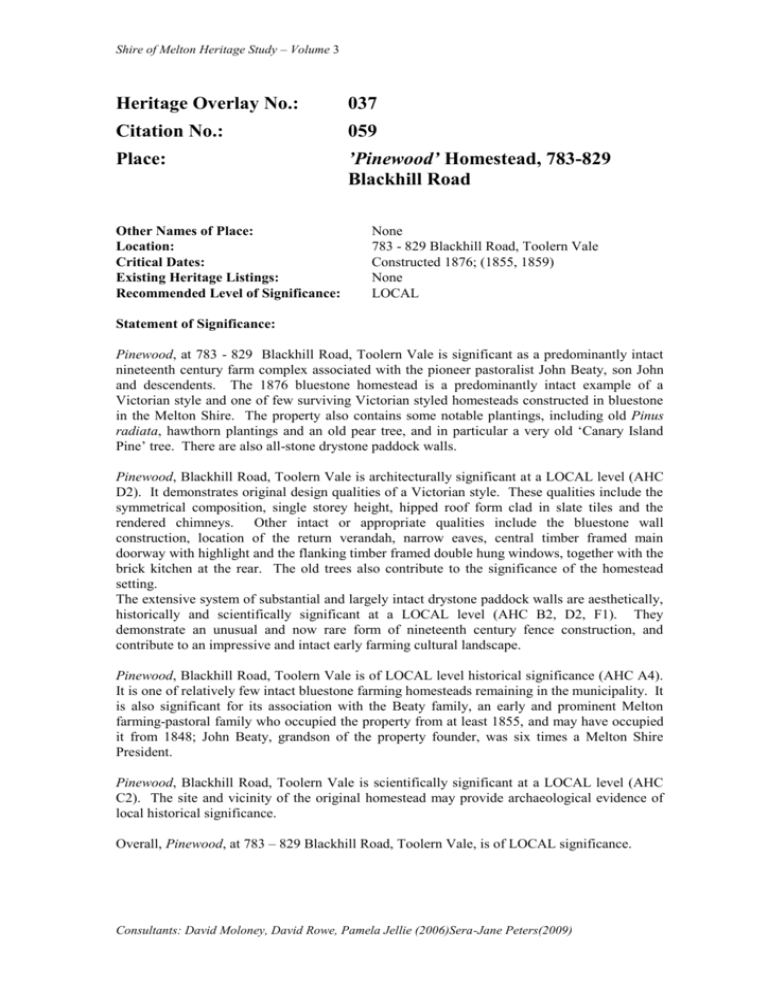
Shire of Melton Heritage Study – Volume 3 Heritage Overlay No.: 037 Citation No.: 059 Place: ’Pinewood’ Homestead, 783-829 Blackhill Road Other Names of Place: Location: Critical Dates: Existing Heritage Listings: Recommended Level of Significance: None 783 - 829 Blackhill Road, Toolern Vale Constructed 1876; (1855, 1859) None LOCAL Statement of Significance: Pinewood, at 783 - 829 Blackhill Road, Toolern Vale is significant as a predominantly intact nineteenth century farm complex associated with the pioneer pastoralist John Beaty, son John and descendents. The 1876 bluestone homestead is a predominantly intact example of a Victorian style and one of few surviving Victorian styled homesteads constructed in bluestone in the Melton Shire. The property also contains some notable plantings, including old Pinus radiata, hawthorn plantings and an old pear tree, and in particular a very old ‘Canary Island Pine’ tree. There are also all-stone drystone paddock walls. Pinewood, Blackhill Road, Toolern Vale is architecturally significant at a LOCAL level (AHC D2). It demonstrates original design qualities of a Victorian style. These qualities include the symmetrical composition, single storey height, hipped roof form clad in slate tiles and the rendered chimneys. Other intact or appropriate qualities include the bluestone wall construction, location of the return verandah, narrow eaves, central timber framed main doorway with highlight and the flanking timber framed double hung windows, together with the brick kitchen at the rear. The old trees also contribute to the significance of the homestead setting. The extensive system of substantial and largely intact drystone paddock walls are aesthetically, historically and scientifically significant at a LOCAL level (AHC B2, D2, F1). They demonstrate an unusual and now rare form of nineteenth century fence construction, and contribute to an impressive and intact early farming cultural landscape. Pinewood, Blackhill Road, Toolern Vale is of LOCAL level historical significance (AHC A4). It is one of relatively few intact bluestone farming homesteads remaining in the municipality. It is also significant for its association with the Beaty family, an early and prominent Melton farming-pastoral family who occupied the property from at least 1855, and may have occupied it from 1848; John Beaty, grandson of the property founder, was six times a Melton Shire President. Pinewood, Blackhill Road, Toolern Vale is scientifically significant at a LOCAL level (AHC C2). The site and vicinity of the original homestead may provide archaeological evidence of local historical significance. Overall, Pinewood, at 783 – 829 Blackhill Road, Toolern Vale, is of LOCAL significance. Consultants: David Moloney, David Rowe, Pamela Jellie (2006)Sera-Jane Peters(2009) Shire of Melton Heritage Study – Volume 3 Description: The symmetrical, single storey, coursed, squared bluestone, Victorian styled house known as Pinewood is characterised by a hipped roof form clad in slate tiles. Early rendered chimneys adorn the roofline. Narrow overhangs are features of the eaves. A feature of the design is the return bullnosed verandah, supported by columns. This verandah may have replaced an earlier verandah. There is an early timber verandah floor and there is timber verandah infill at one end. The symmetry of the design is accentuated by the early timber framed central main doorway with highlight, and the flanking early timber framed double hung windows. Internally, the house features high pressed metal ceilings, original cedar mantleplaces, and some original Beaty furnishings. There are substantial additions at the rear constructed mainly in timber, together with an early brick kitchen. The mature exotic trees at the rear (main) driveway entrance to the house include one old specimen at the homestead gate which, according to Beaty family lore, is a ‘Canary Island pine’ with family historical associations. Inspection reveals that it is in fact an Aleppo pine (Pinus halepensis). The original tree, planted c.1870s, fell in 2001, and remains as a stump on the opposite side of the gateway. The existing pine is said to have been planted c.1900 from a seed from the original. The property may have been named after these trees. There is a more formal garden in the front (east side) of the homestead, which although mostly modern, nevertheless features some Pinus radiata probably more than 100 years old. The original 1850s Beaty homestead was located on the east side of the creek; there is no obvious above-ground evidence of this. Nearby however there is an ancient and exceptionally fine specimen of a Pear tree at the Kororoit Creek. It is situated in a sheltered rectangular paddock enclosed by old dry stone walls and Hawthorn hedges. The extensive boundary and paddock drystone walls (all-stone, rather than composite post-andwire) on the property are substantial in terms of height, are well-built, and mostly in excellent condition (especially the internal paddock walls). The Hawthorn hedge (Crataegus monogyna) is also worthy of note. Further away, old wheel ruts from early gold-field era roads have since been ploughed down. There are the usual outbuildings associated with a substantial farm. The property was very recently sold out of the Beaty family. History: The homestead is situated on Crown Allotment 9, Parish of Yangardook, purchased by John Beaty from the Crown on 19th July 1855.1 It was one of a group of crown allotments that had been purchased by John Beaty in the 1850s, some of which remain the possession of his family today. 1 Parish Plan, Parish of Yangardook Consultants: David Moloney, David Rowe, Pamela Jellie (2006) Shire of Melton Heritage Study – Volume 3 John Beaty, who apparently arrived in the colony in 1848,2 purchased a large allotment at one of the first sales of Crown Land in the district. There is a family belief that he settled on the property years before he purchased the land, perhaps as early as 1848. 3 Pollitt’s earlier history of the Shire which states that ‘Old’ John Beaty settled on the Kororoit between Toolern and Sunbury in ‘1869’ may be meant to read ‘1849’. Pollitt states that Beaty, as with many who prospered in the area, ‘started a carrying business between Melbourne and Bendigo, using bullock teams, and prospered up to the time of the railway’.4 Jointly with a ‘John Beattie’, in August 1852 John Beaty purchased the 482 acre Crown Allotment 20 Parish of Holden at the very good price of ₤578. Five months later, in January 1853, John Beattie sold John Beaty his half share in this allotment for ₤1446.5 (Beattie may have been a relation of John Beaty, as different branches of the family adopted different spellings. For example John Beaty met his brother Charles when he arrived in Melbourne from their native Co. Tyrone Ireland in 1856, but Charles used the spelling ‘Beatty’, and his descendents ‘Beattie’.6 Beattys Road in Rockbank is named after Charles’ branch of the family who occupied the Rockbank Inn from the 1860s to 1970s. Official government records add to the confusion by often spelling John Beaty as ‘Beatty’, and sometimes ‘Beattey’. Confusion is further increased by Henry Beattie, who managed, and eventually partly owned, the adjacent Mt Aitken Station and other nearby property, but who hailed from Scotland and was presumably no relation to John Beaty.7 Henry and his sons, including William and John Aitken, became nationally famous breeders of Hereford cattle, Shropshire sheep, and Leicester and Merino crosses. Another son Walter also owned land in the district.8) Beaty had done well to establish in this area, with the very early pastoral station Green Hills on his west, the famous early squatter and sheep breeder John Aitken to his north and east, and the notorious WJT (Big) Clarke to his south. By 1854 Beaty had a well-established ‘homestead’ on his allotment, situated the east bank of the West Branch of Kororoit Creek. 9 At Crown Land sales 1854-57, Beaty capitalised on his foothold and purchased the majority of his holding, a further 1547 acres. The majority of this land was situated on the west side of the West Branch of Kororoit Creek - formerly part of the Green Hills Station - where his new Pinewood homestation, his son Andrew’s Glencoe, and eventually this house, at 847 Black Hill Road, would be built. He purchased 15 separate but contiguous parcels of land, some of which cost, in this gold-rush period, over ₤4 per acre. In total Beatey acquired some 2030 acres (c.820 hectares) in the 1850s Crown sales. John Beaty senior (‘of Kororoit Creek’) and his wife Elizabeth apportioned their estate between sons John junior, Andrew and William. John junior was ‘granted’ (sold for ₤300, a small sum) the property on West Branch of Kororoit Creek as far west as Blackhill Road, in 1872. 10 On this land (about 716 acres by the late 1880s) the bluestone homestead Pinewood was built by 2 Starr, J, Melton: Plains of Promise (Shire of Melton, nd, c.1985) p.29. John Beaty, personal conversation, 8th May 2002. Also Wesfarmers’ real estate brochure for the property, 2002. 4 Pollitt, JH, An Historical Record of Melton (nd), p.44 5 PROV Torrens Application file: VPRS 460/P0 (39493). 6 Starr, loc cit. International ‘Beatty’ family websites also encompass all spellings of the surname (although male and female Christian names recur constantly in the nineteenth century). 7 Peck, HH, Memoirs of a Stockman, (Stock & Land Publishing, Melbourne, 1972), p. 99; also Beattie, SK, The Odd Good Year: Early Scotes to Port Phillip, Northern Australia, Gap, Gisborne & Beyond, (the Author, Wagga Wagga, 1999), passim. 8 Peck, op cit, pp. 50, 99, 179-181; also Shire of Melton Ratebooks, 1882-1888. 9 Lands Victoria, Put-Away Plan Y27 (1854) 10 PROV Torrens Application file: VPRS 460/P0 (39493), Conveyance John Beaty to John Beaty the Younger,12/2/1872. 3 Consultants: David Moloney, David Rowe, Pamela Jellie (2006) Shire of Melton Heritage Study – Volume 3 John junior.11 John was the youngest of the brothers, and didn’t marry until in his 40s, so Pinewood was the last of the houses built. A notice appears in the Melton Express in March 1876 for tenders to construct ‘five roomed bluestone with brick house for Mr John Beaty, Yangardook.12 This fits the family’s belief that Pinewood was built c.1875, and that, as with the other brothers’ homesteads (Glencoe and Rockands), it was built of stone quarried on Glencoe, other stone tried not being suitable.13 John senior retained some 600 acres in his own name.14 This was probably the site of his original homestead, which was situated nearby, on a flat on the east side of the creek, a complex of house, outbuildings and fenced yards (probably containing a gardern or orchard, stockyard or paddock).15 All that remains of this house is three pinus radiata, an old pear tree, and a hawthorn bush.16 Archaeological evidence of the complex may remain. There are also paddocks fenced by good all-stone drystone walls nearby. John Beaty senior died on 18th November 1999. John senior also transferred land on the east side of the West Branch of Kororoit Creek to son William who built the Rocklands homestead there,17 and to Andrew the property on which the Glencoe homestead was established.18 The drystone walls on the property are thought to have been repaired / rebuilt in the 1920s. John Beaty junior was described as ‘farmer and grazier’ in the early twentieth century. Two of sons, John III (Jack), and Robert, established ‘Beaty Brothers’ Dorset Horn Stud in the 1930s. The brothers’ partnership was dissolved in 1965, after which Robert and his son John continued the Dorset Horn Stud, and called the property Kororoit Park.19 In around 1926 a house (847 Black Hill Road) was built on that part of the property rated as 273 acres, being part of allotments 7, 8 and 9, Parish of Yangardook. It was owned then by the ‘Misses Beaty’ Elizabeth A, Marjory C, and Catherine M - Robert and John III (Jack’s) sisters. The womens’ occupations were given as ‘home duties’, and their place of residence as Pinewood.20 While their mother had been keen to live in the new house, the sisters were happy living at Pinewood. The first occupant of 847 Blackhill Road was Jack Beaty, and then Robert, after he married in 1933.21 John Beaty III (Jack), who lived at Pinewood, was a Melton Shire Councillor from 1919 until at least 1961 (the last of his 6 terms as President).22 11 Shire of Melton Ratebooks, 1887-1888. The Melton Express, 5/3/1876 13 John Beaty, and Mrs D Watt. 14 Shire of Melton Ratebooks, 1887-1888. 15 Shire Map Series, 1892, Parish of Yangarook (SLV 821.A) 16 John Beaty, personal conversation, 8/5/200 17 PROV Torrens Application file: VPRS 460/P0, Unit 817 (48954), Conveyance John Beaty to William Beaty,19/9/1879; also Shire of Melton Ratebooks, 1887-1888. 18 PROV Torrens Application file: VPRS 460/P0 (37508), Conveyance John Beaty to Andrew Beaty, 20/9/1879; also Shire of Melton Ratebooks, 1887-1888. 19 John Beaty, personal conversation, 25/10/2004, 8/5/2002 20 Shire of Melton Ratebooks, 1919-1927. 21 ibid 22 Pollitt, op cit, p.44; Starr, op cit, p.269 12 Consultants: David Moloney, David Rowe, Pamela Jellie (2006) Shire of Melton Heritage Study – Volume 3 By 1936, the address of ‘Robert Alexander Beaty, grazier’ remained in possession of the land to the south of William Beaty’s Rocklands.23 His son John remains lives on this property today, carrying on the Dorset Horn Stud established by his father and uncle. At the homestead (internal) gate of the rear (main) driveway, is an old specimen which according to Beaty family lore is an offshoot of a Canary Island pine that was picked up in the Canary Islands en route to Australia. Inspection reveals that it is in fact an Aleppo pine (Pinus halepensis). The original tree, which the family relates was planted c.1870s and fell in 2001, remains as a stump on the opposite side of the gateway. The existing tree is said to have been planted c.1900 from a seed from the original. The property may have been named after these trees. The ancient and exceptionally fine specimen of a Pear tree near Kororoit Creek is thought to have been the remnant of an orchard situated near the original 1850s Beaty homestead (no longer extant). The extensive boundary and paddock drystone walls (all-stone, rather than composite post-andwire) on the property are believed to have been repaired / rebuilt in the 1920s. The internal paddock walls are in especially good condition. Old wheel ruts on the property, thought to have dated from early gold-field era roads, have since been ploughed down. The house was identified but not assessed in a previous heritage study of the region. 24 Pinewood homestead and farm, of 281 hectares (694 acres) was put up for sale in 2002. The Thematic Context / Comparative Analysis: Melton Historical Themes: ‘Pastoral’, ‘Farming’. Comparable Places in the Melton Shire Historically, Pinewood is comparable to the other surviving substantial masonry homesteads owned by the Beaty family:- Glencoe homestead, and Rocklands homestead. Together, and with the dry stone walls in the vicinity of these homesteads, these mark the story of the early European development of the locality. Architecturally, Pinewood homestead represents one of few surviving Victorian styled homestead buildings in the Melton Shire. Other comparable examples are as follows: Strathtulloh homestead, Greigs Road, Melton South (Place No. 286). This property was established in 1840, although the existing homestead was not built until c.1869. It shares similar Victorian design qualities as Pinewood, as noted in the broad hipped roof form, rendered chimneys, single storey appearance and encircling verandah. Strathtulloh is also constructed of random coursed bluestone. There is also an early kitchen that forms part of the significant building fabric. This homestead is included on the Victorian Heritage Register. Eynesbury homestead, Eynesbury Road, Melton South (Place No. 281). The original section of the homestead was built in the early 1870s. Unlike Pinewood, this 23 Torrens Application 48954, PROV VPRS 460 (Unit 817) Johnston, C, Rural Heritage Study: Western Region Melbourne (Melbourne Western Region Inc, 1994), p.143 24 Consultants: David Moloney, David Rowe, Pamela Jellie (2006) Shire of Melton Heritage Study – Volume 3 Victorian styled dwelling is two storey and is Colonial Georgian in appearance, but shares a similar bluestone wall construction. This homestead is included on the Victorian Heritage Register. Exford homestead, 255 Exford Road, Melton South (Place No. 269). The central portion of this homestead possibly represents the earliest surviving homestead building in the Melton Shire, having been constructed in c.1843 of pise. Unlike Pinewood, Exford is designed in what has been termed a Colonial Gothic style, a rare style in the Melton Shire. The building has an elongated hipped roof form with projecting dormer windows, together with a number of additions. This homestead is included on the Victorian Heritage Register. The Willows, Nixon & McKenzie Roads, Melton (Place No. 226). This Victorian styled homestead was built in the mid 1850s in a rendered random rubble wall construction and with unusual sturdy projecting rendered buttresses. The hipped roof forms (the rear smaller hip having been added at an early time) are familiar with Pinewood, although the roof cladding has been introduced. The concept of the encircling post supported verandah is also similar, although the verandah at The Willows has a separate roof form. Rocklands homestead, 619 Hopkins Road, Truganina (Place No. 391). Built in the late 1850s, this dwelling has a rendered wall finish. The hipped roof form is clad in galvanised corrugated steel and there is a projecting pitched roof addition at the rear. Overall, the homestead appears to be of lower integrity than Pinewood. There are paired timber eaves brackets and unusual label moulds above the windows and doors. Glencoe homestead, 562 Burns Lane (Place No. 5). Built in c.1860s-70s, this dwelling features a similar broad hipped roof form as Pinewood, although the main roof terminates into a broken back encircling verandah. The roof is adorned by rendered masonry chimneys with multi-corbelled tops – the whole designed in a similar Victorian style. Both homesteads are also constructed of coursed squared rubble bluestone. Condition: Excellent Integrity: Predominantly Intact Recommendations: Recommended for inclusion in the Melton Planning Scheme Heritage Overlay Recommended Heritage Overlay Schedule Controls: External Paint Controls: Internal Alteration Controls: Tree Controls: Outbuildings and/or Fences: Yes – the bluestone portions of the homestead. No Yes – the old pine garden and driveway plantings, the Aleppo pine at the front gate, the Hawthorn fence plantings, and the old pear and pine trees near the original homestead site. Yes – the dry stone walls and hawthorn plantings around farm paddocks and front boundary. Consultants: David Moloney, David Rowe, Pamela Jellie (2006) Shire of Melton Heritage Study – Volume 3 Other Recommendations: A preliminary archaeological survey of the original homestead area and early dry stone walls of the place, has the potential to provide further information regarding early pastoral settlement and is desirable. Consultants: David Moloney, David Rowe, Pamela Jellie (2006)


